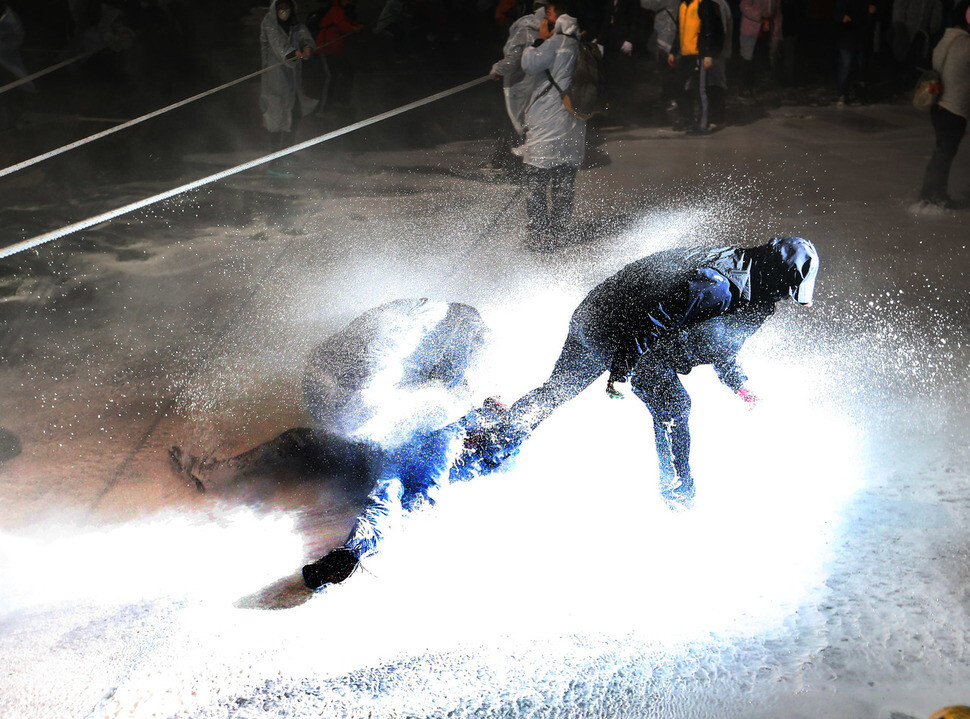hankyoreh
Links to other country sites 다른 나라 사이트 링크
Police announce plans to cease use of police bus barricades and water cannons at demonstrations

South Korea’s police are establishing a new policy of not using police bus barricades and water cannons at demonstrations as a rule. It’s the first measure taken by the police in response to the Blue House’s calls for them to adopt more of a human rights focus.
The National Policy Agency (NPA) announced on May 26 that it was “considering establishing a rule of not using police bus barricades or water cannons at the scene demonstrations apart from exceptional cases in order to maximally guarantee freedoms of assembly and demonstration.”
Lee Dae-hyeong, the NPA’s officer for human rights protections, said at a Busan Metropolitan Police Agency workshop on human rights the same afternoon that the police would “report on assemblies, demonstrations, and police human rights issues at an NPA operational report tomorrow [on May 27] before the governance planning advisory committee.”
“As a rule, we will not be deploying police forces, water cannons, and police bus barricades at assembly scenes,” Lee said.
In response to press reports of Lee’s statements, the NPA acknowledged it was “considering” all areas except non-deployment of police forces.
The change in the police’s approach to assemblies and demonstrations comes in response to Blue House Senior Secretary to the President for Civil Affairs Cho Kuk’s request on May 25 that they present “concrete plans for becoming ‘human rights-oriented police’” with adjustments to their investigative authority. Soon after the Blue House’s request, the police said they would be “reviewing past National Human Rights Commission of Korea (NHRCK) recommendations that were not accepted, and considering whether to introduce them.”

On two separate occasions in 2008 and 2012, the NHRCK recommended that the police specify concrete standards on the use of water cannons in legislation, noting that the use of water cannons “can cause serious harm to the human body.” The police rejected the recommendation, arguing that the water cannons were being “used safely in accordance with the guidelines.” The death of Baek Nam-ki, a farmer who was struck by a water cannon jet during a popular indignation rally in Nov. 2015, led critics to charge that even the guidelines in place were not being observed.
The NHRCK also voiced critical opinions on the use of police bus barricades. In an opinion last year on a report submitted by the Ministry of Justice to the UN Human Rights Committee, the commission said it would be “advisable for the government to guarantee freedoms of peaceful assembly and demonstration by including its active commitment to ensuring peaceful assemblies by refraining from the use of water cannons and police bus barricades and making improvements to the assembly reporting system, which is currently being run as a de facto permit system.”
Civil society welcomed the change in approach from the police, but also said they needed to show a more progressive stance in other ways.
“The basic spirit of the Constitution with its freedoms of assembly and demonstration have been restricted in the past through excessive use of physical force by police, so we welcome this change in the police’s position,” said Park Jin, a full-time activist with the Dasan Human Rights Center.
At the same time, Park also said the police “need to show an effort to address the Baek Nam-ki case first.”
An Jin-geol, secretary-general for the group People’s Solidarity for Participatory Democracy, expressed hope that “a decrease in threatening deployments by police will lead to fewer clashes at the scenes of assemblies and demonstrations.”
“This can’t just be something they do for show for the sake of adjustments to investigative authority. This needs to be an occasion for them to take on a new identity as human rights-oriented police,” An advised.
By Park Su-ji, staff reporter
Please direct questions or comments to [english@hani.co.kr]

Editorial・opinion
![[Editorial] Does Yoon think the Korean public is wrong? [Editorial] Does Yoon think the Korean public is wrong?](https://flexible.img.hani.co.kr/flexible/normal/500/300/imgdb/original/2024/0417/8517133419684774.jpg) [Editorial] Does Yoon think the Korean public is wrong?
[Editorial] Does Yoon think the Korean public is wrong?![[Editorial] As it bolsters its alliance with US, Japan must be accountable for past [Editorial] As it bolsters its alliance with US, Japan must be accountable for past](https://flexible.img.hani.co.kr/flexible/normal/500/300/imgdb/original/2024/0417/6817133413968321.jpg) [Editorial] As it bolsters its alliance with US, Japan must be accountable for past
[Editorial] As it bolsters its alliance with US, Japan must be accountable for past- [Guest essay] Amending the Constitution is Yoon’s key to leaving office in public’s good graces
- [Editorial] 10 years on, lessons of Sewol tragedy must never be forgotten
- [Column] A death blow to Korea’s prosecutor politics
- [Correspondent’s column] The US and the end of Japanese pacifism
- [Guest essay] How Korea turned its trainee doctors into monsters
- [Guest essay] As someone who helped forge Seoul-Moscow ties, their status today troubles me
- [Editorial] Koreans sent a loud and clear message to Yoon
- [Column] In Korea’s midterm elections, it’s time for accountability
Most viewed articles
- 1[Column] The clock is ticking for Korea’s first lady
- 2Samsung barricades office as unionized workers strike for better conditions
- 3S. Korea, Japan reaffirm commitment to strengthening trilateral ties with US
- 4[Editorial] When the choice is kids or career, Korea will never overcome birth rate woes
- 5[Guest essay] How Korea turned its trainee doctors into monsters
- 6Japan officially says compensation of Korean forced laborers isn’t its responsibility
- 7[Editorial] As it bolsters its alliance with US, Japan must be accountable for past
- 8Korea, Japan jointly vow response to FX volatility as currencies tumble
- 9Gangnam murderer says he killed “because women have always ignored me”
- 10Worse than worst case: Korea’s population is shrinking faster than predicted